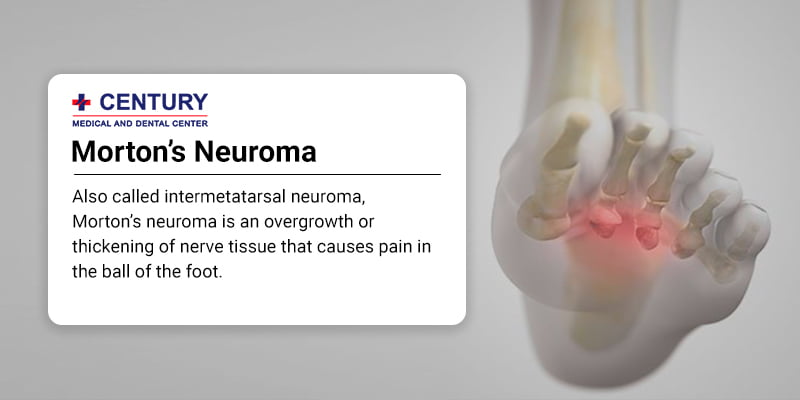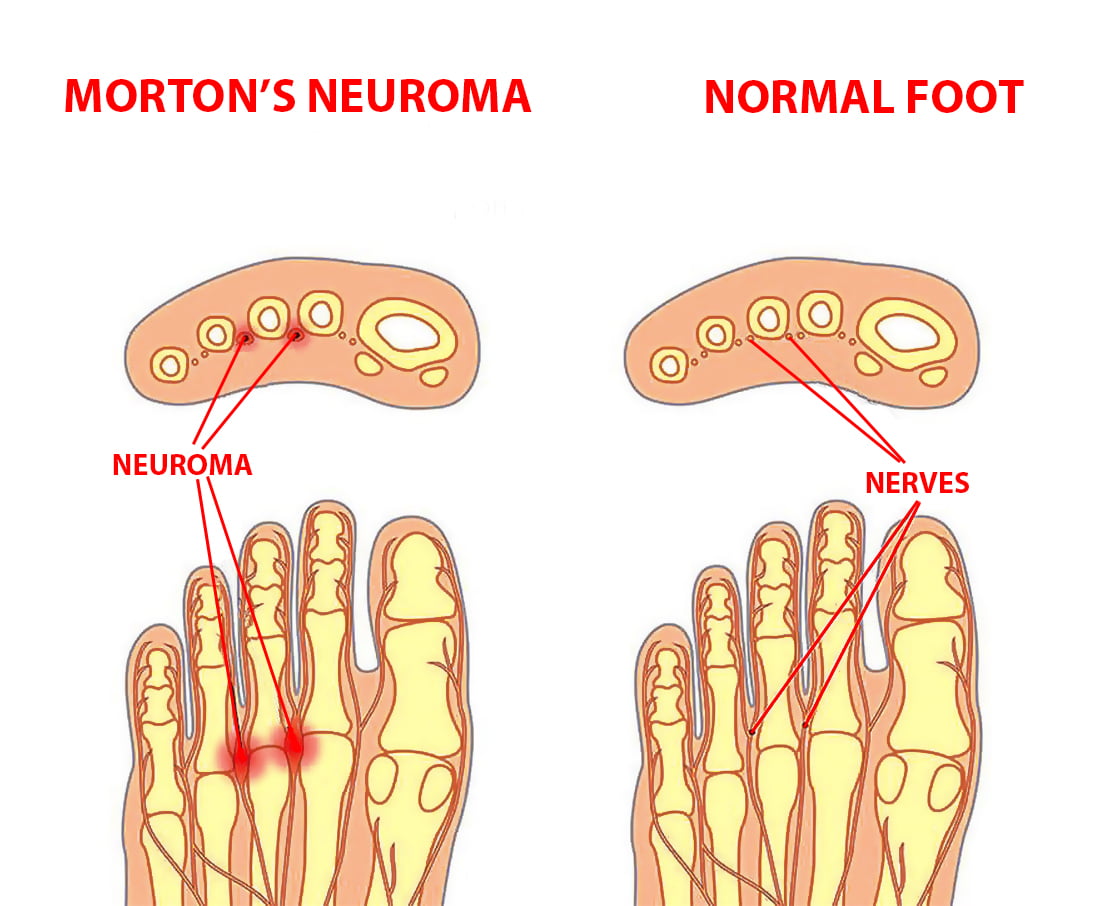If you feel the presence of a pebble in your shoes when you walk, or experience sharp burning pain and numbness between the toes, you have Morton’s neuroma. It involves a thickening of the tissue around one of the nerves, leading to the toes. Long-lasting Morton’s neuroma can be very painful and affect your routine life, making it hard for you to stand or walk easily. Visit a pain management doctor at the Century Medical and Dental Center to have your condition diagnosed and to get the best advice on relieving pain. The top foot doctor recommends the best treatment and therapies to make you better feel better and prevent the overgrowth of the nerve tissue.
Also called intermetatarsal neuroma, Morton’s neuroma is an overgrowth or thickening of nerve tissue that causes pain in the ball of the foot. This condition usually results from repetitive foot overload caused by wearing tight shoes or high-impact sports gear.
Neuromas are tissue growths around the nerves that can occur in several places around the body. Although they are non-cancerous, these growths can trap the nerve, causing pressure and pain. If left untreated, they may cause permanent nerve damage.
Morton’s neuromas occur in the ball of the foot, commonly in the area between the second and third toes or between the third and fourth toes. They grow along the nerves that provide sensation to the toes, resulting in intense pain.

Morton’s neuromas usually develop in response to frequent overload on the foot. Some common causes of Morton’s neuroma include:
Most people do not have any outward signs of Morton’s neuroma or lump to indicate its presence. The problem starts gradually, and you may feel a burning pain. There is only occasional pain when you wear narrow shoes, and it stops when you remove the triggering factor such as pointed shoes or get injured. The pain can intensify as the neuroma grows, and it can last for days and even weeks if it is not managed timely.
Common symptoms of Morton’s neuroma include:

Advanced cases of neuromas require medical treatment as the pain may return in episodes, and you will face considerable discomfort. If you spend a lot of time on your feet or wear tight shoes, you may require repeat treatment.
A neuroma can be completely removed through surgery, but there is a 20-30% chance of regrowth, also known as a stump neuroma. The pain management doctor can guide you in this regard and help you make the necessary lifestyle changes to avoid neuroma development and prevent its regrowth.
If your foot pain does not go away even after changing your footwear and stopping activities that might be responsible, schedule an appointment with your doctor. It is best to seek medical care in the first weeks after you start having foot pain or numbness. The foot doctor can start conservative or non-surgical treatment such as pain-numbing or steroid injections and pain-relieving medications.
If these injections and medications are not helpful, the doctor may recommend radiofrequency ablation or cryoablation. Surgery is the last option to remove the neuroma.
Morton’s neuroma is detected with physical examination, using the patient’s medical history, and the location of the pain. The doctor will also rule out other reasons for foot pain, such as arthritis, joint or ligament problems, and old injures to make an accurate diagnosis.
The doctor will also look for swelling, numbness, weakens, and limited foot motion to ensure no underlying condition is causing these symptoms. Morton’s neuroma pain can be reproduced by squeezing the sides of the foot. In case further testing is needed, the doctor will recommend imaging.
Imaging tests for detecting neuroma include:
Mild to moderate pain can be relieved with pain-relieving medications, lifestyle changes, and non-surgical therapies. More than 80% of the people suffering from Morton’s neuroma feel better with a conservative approach.
First-line conservative treatment includes:
Other conservative treatments include:
They help manage the symptom so that you can get back on your feet without going through too much pain.
If your pain fails to subside after several months of conservative treatment, the foot specialist may recommend advanced treatment that includes injection techniques. They take place in an outpatient setting with local anesthesia for numbing the foot, guided by ultrasound.
The injections are:
Doctors use surgery as the last option if no other treatment works. Surgery widens the space through which the affected painful nerve travels or removes the neuroma.
The patient must avoid standing during the recovery period, as increased pressure or scarred tissue can result in stump neuroma and even more pain.
Doctors recommend simple measures to prevent Morton’s neuroma and decrease its pain. They include:
Morton’s neuroma is a benign condition, but it can be painful and even lead to permanent nerve damage and walking disabilities if you do not seek medical attention.
The experienced and board-certified foot doctors at the Century Medical and Dental Center work hard to keep you and your family as active as ever, despite these painful conditions. They use the best diagnostic tools to learn more about your pain and develop effective solutions to manage it while your body heals. For most people, changes in footwear, life adjustments, and exercises are enough to ease or stop the symptoms. If they fail to work for you, the pain management doctors come up with advanced treatment methods, including surgery to prevent benign nerve growth and help you get back on your feet and routine life.
SHARE THIS POST Page Updated on Apr 10, 2025 by Dr. Dvorkina (Primary Care Doctor) of Century Medical & Dental CenterCentury Medical and Dental Center is an accredited healthcare facility in NY that operates in accordance with Article 28, a public health law. This law regulates and recognizes accreditation for public healthcare facilities, ensuring they are licensed and operated correctly. By undergoing the Article 28 process and achieving accreditation, Century Medical and Dental Center demonstrates its commitment to meeting the highest standards of care.
As a multidisciplinary medical center, we have highly qualified doctors, nurses, and support staff who are working hard to provide the best medical care to patients in Manhattan, NY, Brooklyn, NY, and Bronx, NY including Brooklyn Heights, Dumbo, Prospect Heights, Park Slope, Clinton Hill, Boerum Hill, Red Hook, Harlem, Gravesneck, Flatbush, and Bedford-Stuyvesant.